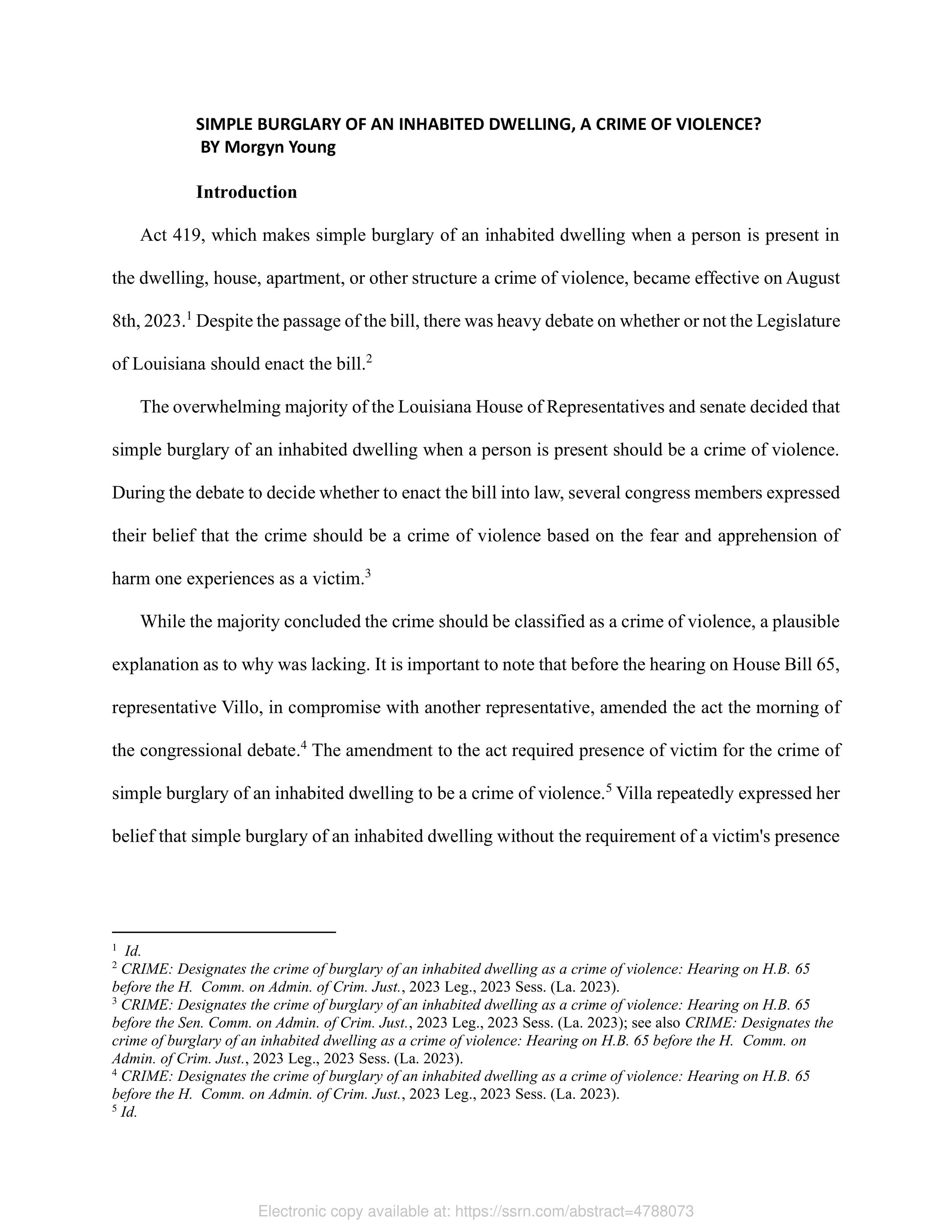By Morgyn Young
Recently, Louisiana classified Simple Burglary of an Inhabited Dwelling, when a person is present during the commission of the crime, as a crime of violence. The overwhelming majority in both the House and the Senate voted to deem the crime a crime of violence. Yet, LA. REV. STAT. § 14:60 (Simple Burglary of an Inhabited Dwelling) does not contain an inherently violent element. In this note, the Author takes a deep dive into the Louisiana Code to uncover the foundation needed to classify a crime as a crime of violence. In doing so, it becomes apparent that Louisiana has begun to stray away from a traditional notion of violence. Many of the amendments, including La. Rev. Stat. § 14:60, do not follow conventional notions of violence in that they do not have a nexus to physical injury. This expansion has reached the point where there is no longer a list of attributes that can be used to determine a crime of violence.
Throughout the article, the Author uses Simple Burglary of an Inhabited Dwelling when a person is present as an example to further portray the idea that the Legislature does not follow the crime of violence definition listed in the code, nor is there a readily apparent framework utilized when deeming crimes "violent." To begin, the Author explores how the definition of a crime of violence has grown outside the bounds of the traditional definition of violence by comparing differing "violence" definitions, both past and present. The Author notes that the definition of violence is constantly evolving. However, the Legislature has expanded far past the modern definition. The Author furthers the analysis by examining the different crimes the Legislature has deemed violent compared to La. Rev. Stat. 14:40. Through the study, it becomes clear that the Legislature, as a whole, cannot define violence effectively, nor does the enumerated list under a crime of violence reveal a consistent determination. As in, the Legislature has not plausibly categorized violent crimes. In further explanation, when singling out just the property crimes listed as a crime of violence, there is not a consistent attribute between the crimes listed to determine what escalated each crime to a crime of violence. The Author ends the analysis by attempting to define the elements of La. Rev. Stat. § 14:2, which proves to be quite challenging as the Louisiana Supreme Court has not provided much insight into the framework of classifying a crime. The elements of importance consist of physical force, substantial risk, and the ordinary case of an offense. The Author continues by comparing Louisiana's definition of a crime of violence to the United States Code's definition. The Author points out the resemblance between the two statutes, yet verbiage contained in 18 U.S.C § 16 was deemed unconstitutional. Using both statutes, multiple cases, and burglary statistics the Author further proves the idea that simple burglary of an inhabited dwelling, when a person is present, should not be classified as a crime of violence. As the crime does not entail physical force to the victim, an intent to harm a person, nor is the risk of harm to the victim substantial. Additionally, the offense cannot be correlated with the existing property crimes labeled a crime of violence, and the offense cannot be classified a crime of violence under the definition provided in La. Rev. Stat. § 14:2. Ultimately, this demonstrates the Legislature's sway from a traditional definition of violence and the legislature acting without limitation in classifying crimes as violent. This never-ending expansion or overreaching fuels an ineffective judicial system, ultimately affecting every citizen in some shape or form.
Unpublished paper, 2024. 27p.


